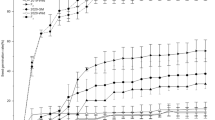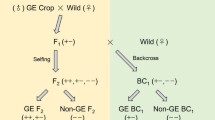Abstract
With the proliferation of genetically modified (GM) products and the almost exponential growth of land use for GM crops, there is a growing need to develop quantitative approaches to estimating the risk of escape of transgenes into wild populations of crop relatives by natural hybridization. We assessed the risk of transgene escape by constructing a population genetic model based on information on fitness-related QTLs obtained from an F 2 population of wild soybean G. soja × cultivated soybean Glycine max. Simulation started with ten F 1 and 990 wild soybeans reproducing by selfing or outcrossing. Seed production was determined from the genetic effects of two QTLs for number of seeds (SN). Each seed survived winter according to the maternal genotype at three QTLs for winter survival (WS). We assumed that one neutral transgene was inserted at various sites and calculated its extinction rate. The presence of G. max alleles at SN and WS QTLs significantly decreased the probability of introgression of the neutral transgene at all insertion sites equally. The presence of G. max alleles at WS QTLs lowered the risk more than their presence at SN QTLs. Although most model studies have concentrated only on genotypic effects of transgenes, we show that the presence of fitness-related domestication genes has a large effect on the risk of transgene escape. Our model offers the advantage of considering the effects of both domestication genes and a transgene, and they can be widely applied to other wild × crop relative complexes.

Similar content being viewed by others
References
Abe J, Hasegawa A, Fukushi H (1999) Introgression between wild and cultivated soybeans of Japan revealed by RFLP analysis for chloroplast DNAs. Econ Bot 53:285–291
Broich SL, Palmer RG (1980) A cluster analysis of wild and domesticated soybean phenotypes. Euphytica 29:23–32
Ellstrand NC (2003) Dangerous Liaisons? When cultivated plants mate with their wild relatives. Johns Hopkins University Press, Baltimore, Maryland
Fujita R, Ohara M, Okazaki K, Shimamoto Y (1997) The extent of natural cross-pollination in wild soybean (Glycine soja). J Hered 88:124–128
Hails RS, Morley K (2005) Genes invading new populations: a risk assessment perspective. Trends Ecol Evol 20:245–252
Han OK, Kaga A, Isemura T, Wang XW, Tomooka N, Vaughan DA (2005) A genetic linkage map for azuki bean. [Vigna angularis (Willd.) Ohwi & Ohashi]. Theor Appl Genet 111:1278–1287
Haygood R, Ives AR, Andow DA (2003) Consequences of recurrent gene flow from crops to wild relatives. Proc R Soc Lond B Biol Sci 270:1879–1886
Hymowitz T, Singh RJ (1987) Taxonomy and speciation. In: Hymowitz T, Singh RJ (eds) Soybeans improvement, production, and uses. American Society of Agronomy and Crop Science Society of America, Madison, Wisconsin, pp 23–48
Jenczewski E, Ronfort J, Chevre AM (2003) Crop-to-wild gene flow, introgression and possible fitness effects of transgenes. Environ Biosafety Res 2:9–24
Kaga A et al (2005) Exploration and collection for hybrid derivatives between wild and cultivated soybean: preliminary survey in Akita and Hiroshima Prefectures, Japan. Ann Rep Exploit Intro Plant Genet Res 21:59–71
Keim P, Diers BW, Shoemaker RC (1990) Genetic analysis of soybean hard seededness with molecular markers. Theor Appl Genet 79:465–469
Kelly CK, Bowler MG, Breden F, Fenner M, Poppy GM (2005) An analytical model assessing the potential threat to natural habitats from insect resistance transgenes. Proc Soc Lond B Biol Sci 272:1759–1767
Kollipara KP, Singh RJ, Hymowitz T (1997) Phylogenetic and genomic relationships in the genus Glycine Willd. based on sequences from the ITS region of nuclear rDNA. Genome 40:57–68
Kosambi DD (1944) The estimation of map distance from recombination values. Ann Eugen 12:172–175
Kuroda Y, Kaga A, Apa A, Duncan AV, Tomooka N, Yano H, Matsuoka N (2005) Exploration, collection and monitoring of wild soybean and hybrid derivatives between wild soybean and cultivated soybean: based on field surveys at Akita, Ibaraki, Aichi, Hiroshima and Saga Prefectures. Ann Rep Exploit Intro Plant Genet Res 21:73–95
Kuroda Y, Kaga A, Tomooka N, Vaughan DA (2006) Population genetic structure of Japanese wild soybean (Glycine soja) based on microsatellite variation. Mol Ecol 15:959–974
Liu B, Fujita T, Yan ZH, Sakamoto S, Xu D, Abe J (2007) QTL mapping of domestication-related traits in soybean (Glycine max). Ann Bot 100:1027–1038
Lu CM, Kato M, Kakihara F (2002) Destiny of a transgene escape from Brassica napus into Brassica rapa. Theor Appl Genet 105:78–84
Mather K, Jinks JL (1971) Biometrical Genetics. Chapman and Hall, London
OECD (2000) Series on Harmonisation of Regulatory Oversight in Biotechnology, No. 15: Consensus Document on the Biology of Glycine max (L.) Merr. (Soybean). http://www.olis.oecd.org/olis/2000doc.nsf/LinkTo/env-jm-mono(2000)9. Accessed 18 August 2010
Peng J, Ronin Y, Fahima T, Roder M, Li Y, Nevo E, Korol A (2003) Domestication quantitative trait loci in Triticum dicoccoides, the progenitor of wheat. Proc Natl Acad Sci USA 100:2489–2494
Song QJ, Marek LF, Shoemaker RC, Lark KG, Concibido VC, Delannay X, Specht JE, Cregan PB (2004) A new integrated genetic linkage map of the soybean. Theor Appl Genet 109:122–128
Stewart CN, Halfhill MD, Warwick SI (2003) Transgene introgression from genetically modified crops to their wild relatives. Nat Genet 4:806–817
Van Ooijen JW, Voorrips RE (2001) JoinMap 3.0 software for the calculation of genetic linkage maps. Plant Research International, Wageningen, The Netherlands
Watanabe S, Tajuddin T, Yamanaka N, Hayashi M, Harada K (2004) Analysis of QTLs for reproductive development and seed quality traits in soybean using recombinant inbred lines. Breed Sci 54:399–407
Weis AE, Hochberg ME (2000) The diverse effects of intraspecific competition on the selective advantage to resistance: a model and its predictions. Am Nat 156:276–292
Acknowledgments
We would like to give special thanks to Dr. H. Yano and Mr. N. Matsuoka of the Agricultural Research Center for the Western Region for their support in the field. This study was supported by the Research Fund for “Assurance of Safe Use of Genetically Modified Organisms” from the Ministry of Agriculture, Forestry and Fisheries of Japan and the Global Environment Research Fund of the Ministry of the Environment of Japan (FY2003–2005).
Author information
Authors and Affiliations
Corresponding author
Additional information
Handling Editor: Paul Christou.
Rights and permissions
About this article
Cite this article
Kitamoto, N., Kaga, A., Kuroda, Y. et al. A model to predict the frequency of integration of fitness-related QTLs from cultivated to wild soybean. Transgenic Res 21, 131–138 (2012). https://doi.org/10.1007/s11248-011-9516-8
Received:
Accepted:
Published:
Issue Date:
DOI: https://doi.org/10.1007/s11248-011-9516-8




